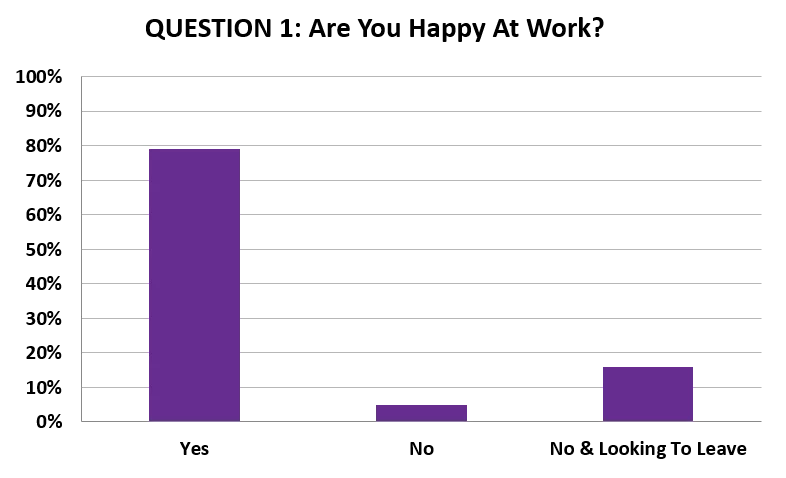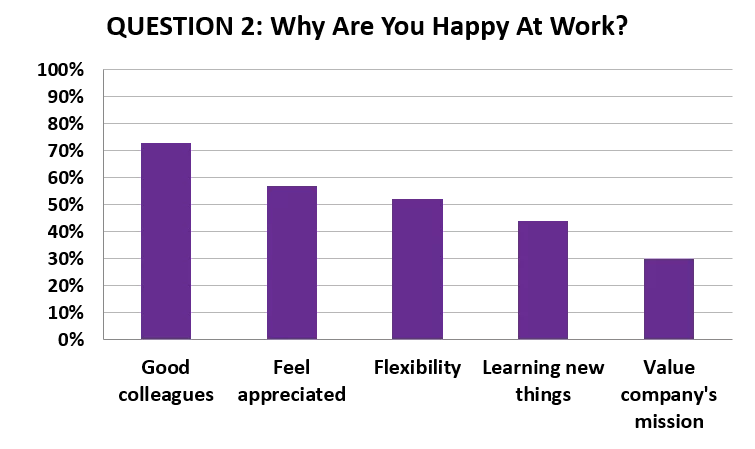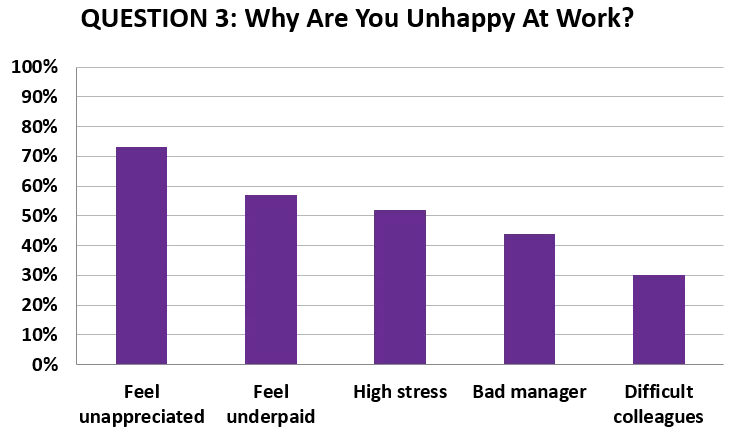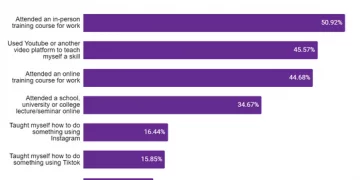
Employee Happiness Statistics & Facts – 2024 Research
What makes employees happy?
Lots of people are reassessing their work now that coronavirus restrictions have been lifted.
To find out more, we conducted new, original research to look at what the key drivers of employee happiness & job satisfaction (or lack of!) are in 2021.
We polled 500 employees across a wide variety of industries to understand:
- Are they happy at work?
- If they are happy at work, what makes them happy?
- If they are unhappy at work, what makes them unhappy?
For more details of our sample size and methodology, see the bottom of this article.
We have recently also published an article on Assertiveness Statistics! A key skill for any modern worker.
Key Takeaways: Job Satisfaction Statistics & Employee Satisfaction Statistics
79% of employees are happy in their role.
5% of employees are unhappy but not looking to leave their current role
16% of employees (1 in 6) are actively looking to leave their current role.
The key drivers of this were:
#1: Unhappy employees don’t feel valued, happy ones do.
It was the number 1 reason (69%) that unhappy employees gave for being unhappy and the number 2 reason (57%) that satisfied employees gave for being happy with their job.
#2: Good team spirit is the biggest contributor to happy employees.
Enjoying being part of a team with good colleagues was the number 1 reason (73%) given by happy employees. Difficult colleagues was the number 5 reason (38%) given by unhappy employees.
QUESTION 1: ARE YOU HAPPY IN YOUR JOB?
This question was used to split the respondents into happy employees, unsure employees and employees looking to leave.
Encouragingly, this showed that almost 4 in 5 people are happy in their roles. It also showed that people have high expectations for their jobs and are not easily satisfied.
Of the people who were unhappy, more than 75% are looking to leave their current role. People are not happy to stay in jobs that they do not enjoy.
QUESTION 2: WHY DO YOU ENJOY YOUR JOB?
This question was used to identify why happy employees are happy.
It is interesting to know how many people are unhappy or unsatisfied, but much more useful to know what drives employee satisfaction.
Again, they could choose more than one answer. On average, they gave 2.9 answers each. The top 5 answers were.

None of these answers is about money. They are all about the human aspects of work.
Having good colleagues makes for a happy workplace which is clearly one of the biggest drivers of people’s work satisfaction.
Similarly feeling appreciated is a very soft, human answer.
If “good colleagues” refers to people’s peers then “feeling appreciated” refers to feelings about their managers, and primarily to their line managers who they will deal with most days.
This would support other pre-corona virus research that demonstrated the critical role of line managers in maintaining high levels of employee engagement (CIPD). Building strong relationships is a key part of our line management training.
Looking at the next two answers- flexibility and learning new things – these also sit with someone’s line manager and show the value of good management. Both will take time and energy from a line manager but this research shows the benefits that will accrue from this work.
QUESTION 3: WHY DO YOU WANT TO LEAVE YOUR CURRENT ROLE?
Respondents who said they were unhappy with their current role were asked to identify why they are unhappy in their current role.
They could choose more than one answer. On average they gave 3.6 reasons each.

Interestingly, again feeling underpaid was not quoted as the primary reason for being unhappy at work, although it is close.
Other research has shown that feeling appreciated is the biggest driver of employee satisfaction. This shows that the opposite applies as well. Feeling unappreciated is the biggest driver of employee dissatisfaction.
Unsurprisingly ,’Feel underpaid’ also appears very high on the list. Often it appears as the number 1 reason for employee dissatisfaction in other research.
Other reasons given, like ‘high stress’, ‘bad manager’ and ‘difficult colleagues’, all also highlight the value that people place on the human aspects of work. Good time management can help deal with these issues (other than ‘bad manager’) – read our article here on Time Management Statistics to see just how many people think they handle themselves well! This is the other side of the research we discussed above which shows the impact that good managers can have on people’s work satisfaction.
Methodology: Employee Satisfaction Statistics Research
The research for these job happiness statistics was carried out using Pollfish. 500 people were surveyed.
It polled a representative sample of working people. It was split between male (45%) and female (55%).
It was evenly split between age groups with 20% of the replies being received from people in each of the following age categories.
- 18-24
- 25-34
- 35-44
- 45-54
- 54-65
To separate the ‘unhappy’ employees in our survey into the unhappy but not likely to leave (‘dissatisfied’) and the unhappy and very likely to leave we asked them if they would leave their current job for a new job in the same position and on the same pay as their current job.
These employees were so unhappy that they would put up with the uncertainty and effort of moving employers just to change their work environment. They confirmed that they would move to the same job, on the same pay at a different employer if the opportunity arose.
Looking for Statistics on something more specific? Check out our Excel Facts and Stats here.


